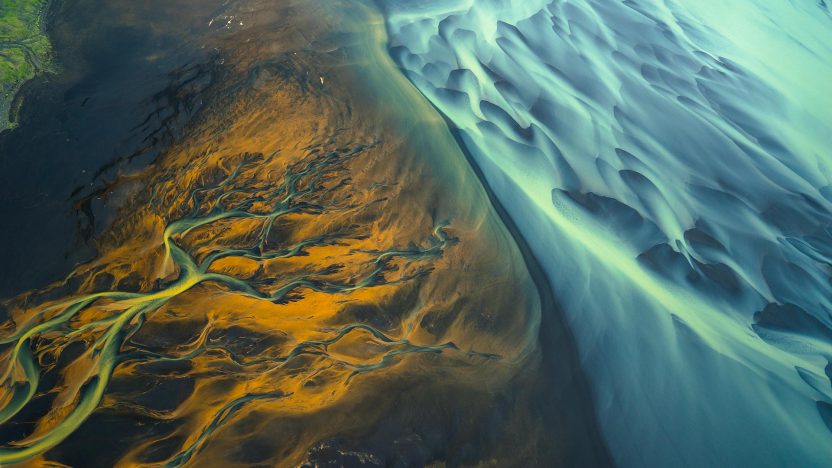What are microplastics?
Microplastics have rapidly become an issue of concern for both human and non-human's health. But what are they exactly?
by MAIZE

Usually, when talking about man-made pollutants, some images spring to mind: thick layers of smog covering immense megalopolises, industrial chimneys spewing black smoke, oil leaking from a tanker onto a calm blue sea, illegal dumping of radioactive waste. This instant image is correct but, quite often, as they say, the devil is in the detail: microplastics. They are ubiquitous, all around us and even inside of us. Unfortunately, their potential harmfulness is inversely proportional to what we know about them.
Out of sight, out of mind
According to the US National Oceanic and Atmospheric Administration, they are small plastic pieces whose size ranges from one nanometer to 5 millimeters. In this field, NOAA is the authority since for some time their scientists have believed that microplastics were damaging the marine ecosystems and that their pollutant action was confined to them. Without them, it would have taken some time to realize that it isn’t so. However, even when the cleanest hypothesis seemed to be holding, ocean conservationists didn’t know much about these poisoning little fragments.
Until about 20 years ago, the scientific community paid little attention to microplastics, mainly because they are a by-product of the second post-war oil-based industrial growth, so there was not an established research tradition concerning them. Strangely enough, although the world’s economy went through radical transformations over the last 70 years, we maintained a Dickensian view of pollution, while garbage patches were appearing in the Pacific Ocean, being noticed only when their surface equaled that of France.
Microplastics under the microscope
According to official figures, 335 million tons of plastic are produced yearly and 8 million of them end up in the sea, a figure that could increase by tenfold if actions are not taken. If pollution is not halted, by 2050 there will be more plastic than fish in the ocean, says the World Economic Forum. From generic to specific, there are 7 kinds of plastic which cover the lion’s share as far as production is concerned, accounting for around 80% of total European plastic consumption: they are Polycarbonates, Polyethylene, Polyethylene terephthalate, Polypropylene, Polystyrene, Polyurethane, and Polyvinyl chloride. Our economy relies on them. Of all the above, Polyethylene is the most requested, for its versatility, processability, and low price. Demand for its resins rose by 4% in 2018, mainly driven by Chinese consumption, (with a 20% increase year on year), for a market value totaling some $164 billion. Plastic bags and containers, bottles included, are made of it.
Scientists used to distinguish between primary and secondary microplastics. The first category includes small particles, like the microbeads widely used in health, hygiene, and beauty products. They are so tiny that they pass through water filtration systems. Somewhere between 15% and 30% of microplastics belong in this category. Secondary microplastics are those deriving from larger plastic pieces, such as bottles, plastic bags, and containers which have broken down after prolonged exposure to the elements.
Some scientists also consider a third type, while others see it as a subcategory: these are microplastics produced anthropogenically, as fragments of tires lost on the road and taken by the wind or synthetic fibers dispersed through the washing machine’s cycles: according to a 2016 study, one cycle alone can produce and scatter around 700,000 invisible plastic fragments. A landmark study led by the University College Dublin found that 85% of microplastics tested were synthetic fibers used in the clothing industry. A fleece jacket can release up to 250,000 particles, 40% of which pass into the wastewater.
Mermaids are crying
Long is the road from the plants where those polymers are molded and the sea, but plastic easily finds the way, even not by itself. Ocean-dumping from the ships crisscrossing the globe by the thousands is a major source of pollution but not the only one; among the many others, there are accidental industrial spills, beach littering, and sewage. On and on, some 5 trillion plastic pieces are floating in the sea, which means around 250,000 tons of debris. And this is just the tip of the plastic iceberg.
By looking at the bottom of the sea, scientists made a horrific discovery: “The deep sea is a major sink for microplastic debris,” as a 2014 paper by Royal Society Open Science wrote. The authors had taken a look at the results from the sediments collected independently by the University of Barcelona and by the London’s Natural History Museum in submarine canyons, continental slopes, basins, and seamounts. Each of the twelve samples revealed plastic microfiber abundance, ranging from 1.4 to 40 pieces per 50 milliliters.
In 2018, marine biologists were shocked by the absolutely abnormal concentration of microplastic debris in the most remote and deepest recesses of the world, such as the hadal zone, the deepest region of the ocean. In particular, hadal sediments of the Mariana Trench were steeped in microplastic, with a density ranging from 200 to 2,200 pieces per liter. Scientists know that those fragments will stay there until bacteria obtain the ability to break down plastic carbon-carbon bonds, which is far from a certainty. What marine biologists don’t know, is how much damage these unnatural elements will inflict to the marine ecosystem, how severe the damage will be and where.
Plastic can be mistaken for food by animals, thus entering the food chain and ultimately reaching the human gut. According to a recent study, published in the journal Environmental Science and Technology, the average person swallows at least 50,000 plastic particles a year. Many of them contain toxins like Bisphenol A, which could seriously alter the food chain. Many studies have proven that they affect marine biology by reducing growth and shortening lifespans.
Say goodbye to reefs
What if this debris is permanently damaging the whole ecosystem? Steve Allen, a researcher quoted by the New York Times last April, suspects that by blocking the gut of fish and insects, microplastic can “have an impact on the animal endocrine system and the lymphatic system, which regulate the production of hormones and the elimination of bodily toxins.” However, the expert said, it also modifies the environment’s chemical composition, “by absorbing pheromones that fish and insects depend on to trigger their fight-or-flight response.”
Another piece of research, carried out at the Portaferry Marine Laboratory in Northern Ireland, has shown that mussels exposed to doses of non-biodegradable microplastics over 52 days lose half of their power to stick to surfaces because they start producing less byssal threads, the tiny fibers that enable them to attach to rocks. If they are unable to attach themselves in places such as reef, there would be a cascading effect on marine biodiversity since reefs play such a pivotal role in the whole ecosystem. And beyond, for they protect the coastline from the damaging effects of waves and tropical storms, provide essential nutrients for the marine food chain and help carbon and hydrogen fixing. They are home to incredible biodiversity, providing shelter and food to fish and other animals, humans included. According to Nature, the reefs help sustain around one billion people and provide services whose value, considered globally, would amount to $172 billion per year.
Nothing left untouched
Water is now almost a lost cause. The most important resource to life is maybe also the most polluted: 83% of tap water samples collected around the world revealed a high concentration of microplastics. In the US, the average is far higher, at 94%, but it shouldn’t be a surprise, since these particles have been found in the limestone aquifers in Illinois. A study by the nonprofit journalism organization Orb Media found traces of plastic in 93% of 250 water bottles sampled internationally, while research conducted by the Bangor University, Wales, detected these polluting elements in each of the 10 lakes, rivers and reservoirs it sampled. River Tame, in Manchester, turned out to be the most polluted river in the UK but microplastics have been found even in the most remote bodies of water, such as Loch Lomond, in Scotland.
Unfortunately, things don’t change much on land. A very recent study published in Nature Geoscience showed that microplastics are also an airborne pollutant. Scientists collected samples of terrain from a very remote spot in the Pyrenees, some 120 kilometers from Toulouse, and found that an average of 365 pieces of microplastics per square meter falls from the sky daily. The wind can transport them across an astonishing 3,500 kilometers. The smaller those fragments are, the farther they go. And all roads lead to the human gut, as proved by gastroenterologist Philipp Schwabl during the last United European Gastroenterology Meeting, held in Vienna in October. Nine out of 10 of microplastics varieties tested were found in the stools of his 8 subjects coming from different countries, including Italy, Japan, and Russia. They all tested positive.
Some countries are running for cover by banning the use of some kinds of microbeads in the cosmetic industry or by banning the use of plastic bags or imposing a fee on them. The latter solution gave better results than an outright ban. In Ireland, for example, it contributed to the steep fall of the average of bags used per person: 328 in 2002 (before the 15 cents fee), while today that number stands at 14. Every attempt is useful and helps to make people aware, but it is too little, and it could be too late. We’ve been poisoning the Earth for years. With what long-term consequences is still to be seen.


